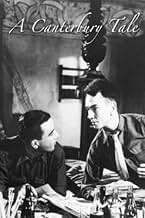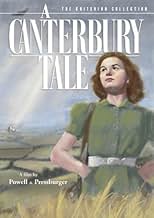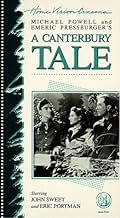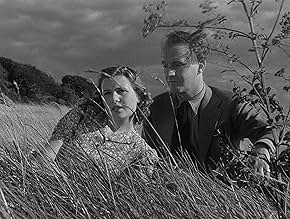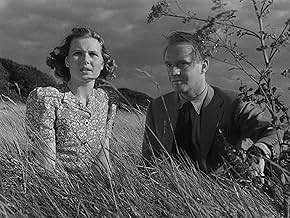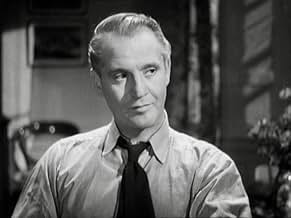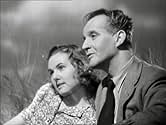अपनी भाषा में प्लॉट जोड़ेंThree modern-day pilgrims investigate a bizarre crime in a small town while on their way to Canterbury.Three modern-day pilgrims investigate a bizarre crime in a small town while on their way to Canterbury.Three modern-day pilgrims investigate a bizarre crime in a small town while on their way to Canterbury.
- निर्देशक
- लेखक
- स्टार
- Sergeant Bob Johnson
- (as Sergt. John Sweet U.S. Army)
- Sergt. Bassett
- (as Antony Holles)
फ़ीचर्ड समीक्षाएं
First -- I loved the camaraderie that developed immediately among all the ordinary folks thrown together and forced to work as teammates for the common cause. (If war is good for anything, it must be that.) Second -- I liked the tall skinny American soldier and the difficulties and simple pleasures he found among the Brits -- I've been there, done that, and P&P captured the feeling very nicely. (Note: Bob Johnson's accent is quite authentic for a rural Oregonian, so stop complaining, you funny Commonwealth lot!). Third -- I enjoyed every minute that Sheila Sim was on camera. Finally -- that cut in the prologue, from the hawk to the fighter plane, was excellent indeed. (And yes, I'd bet my piggy bank that Stanley Kubrick got his idea for the bone-to-space station cut in 2001 from this very film.)
But wait, I realize that I do have to register one last complaint. I love black & white movies, so much that whenever I hear twentysomething kids whine that they can only watch movies in color, I am nauseated. And yet -- I wager that any filmmakers who purport to represent the beauty of the Kentish countryside on a summer day will truly achieve their goal only if they film in color. England's green and pleasant land just can't be painted in shades of gray.
ACT is a pleasant inconsequential masterpiece, with no heavy points to labour, no axes to grind and for wartime not too many flags to wave. But it leaves you wishing that Olde England could've been better preserved from the elected savages in charge of us since, and that perhaps it wasn't so surprising that people were ready to defend such a country and its lifestyles to the death. The only thing Chaucer inspired in me in all of his tales was the desire to reach the end of the journey.
The story? Mysterious fetishist keeps pouring glue onto unsuspecting girls heads at night - 3 intrepid souls determine to find and unmask the weirdo, but vacillate when their moment comes. The four main characters weave in and out of the tale, moving it forward gently to the rather grand climax. But what about the Glueman himself - did he go back home to his reprehensible pastime or did he meet a sticky end? Did Bob get his marijuana? Did they manage to get the moths out of Allison's caravan? Did Peter ever stop playing on his organ?
Refreshing: 1/ A platonic relationship between three handsome men and one beautiful woman. 2/ The most violent scene is where the troops burst out clapping the Sgt. who repaired the slide projector. 3/ A basic plot premise so flimsy and yet so captivating.
A most profitable way of spending two hours.
The plot, such as it is, is bizarre. A small village in Kent is being terrorised by a madman who puts glue in women's hair during the blackout. The GI, the Sergeant and the Land Girl resolve to find the culprit.
All roads lead to Canterbury, where the Cathedral oversees the resolution of the mystery and of the disappointments in the characters' lives, before the soldiers set off on a more dangerous pilgrimage.
In the end, the plot is unbelievable, the character of Culpepper the magistrate unfathomable, the symbolism of the Cathedral laid on with a trowel - yet, why is this such a satisfying film? I think that there is a spirit which shines through this film - an optimism, a determination. The Land Girl has lost her Pilot fiancée, she grieves yet she is not downhearted. The GI loves and misses his homeland but can compare timber preparation techniques with the local blacksmith and find commonality. The English Countryside is ravishing throughout.
This film subtly highlights the values being fought for, the personal values, the village way of life, the spirit exemplified by the history of the Canterbury Pilgrims and of the Cathedral itself. And it is by tapping into the British psyche so deeply that even today it resonates which makes it a great film.
This is an odd movie. The goofy-sounding Glue Man mystery is an unusual pretext to keep the characters together, but it works. The true aim of the film seems to be reconnecting a war-battered audience with its history and bucolic country landscapes. There's a bit of the mystical, with discussions of centuries past and the lingering ghosts of ancestors. The film also serves as a bit of American-British co-operation propaganda, in the form of Sweet's amiable Oregonian Bob. Sweet was an actual U. S. G. I. loaned to the film, an unprofessional actor, and it shows, but in a good way. His voice and personality may strike some the wrong way, but I found him charming. Both Sheila Sim and Dennis Price were also unknowns, and they both went on to fame, but Sweet became a school teacher. Recommended.
Too many of today's critics obsess about the "Lesbian" farm woman whose character, in the 1940's, would have been ordinary and been regarded as being ordinary: a woman raised under the sterner discipline and mores of her day, with no-nonsense, no-b.s. values of virtue, obligation and hard work - and of getting to the point. It's postmodernists' affectation to automatically suspect doughty, matter-of-fact women characters - any eccentric women characters whom their postmodernist Miss Jean Brodie nonsense has bent them to suspect of fitting their screwy postmodernist (i.e., most often Marxisant, but often also Romantic) worldview - in earlier films of being "Lesbians." This woman is, consummately, a farmer who has to consider pragmatically what all farmers have always had to consider: how to smartly, efficiently work their land to its top yield against time and weather, pests and parasites, poachers and market conditions; there's nothing "Lesbian" about any of her singleminded agrarian pragmatism, or about her unremarkable - for her day - country ladies' sartorial choice, or even about her puffing a cigarette.
'A Canterbury Tale' isn't among the best of Powell & Pressburger's efforts; but it doesn't fall far short of their best. In a spot or two the plot plods, but then plodding was the pace of the Kentish countryside, so I think that it's only to our early third millennium sensibilities that it seems to plod. Seldom has black & white cinematography managed, as it manages here, to communicate through chiaroscuro the pilgrims' unease, and through the blessed splendor of sunlit, cloud-garlanded vistas of the Weald of Kent their respite.
As the Glueman strives to communicate the pace, sensibilities, and sensations of Chaucer's pilgrim's time, so too must we latter-day viewers accommodate our viewing of this film to the pace, sensibilities, and sensations of its period and setting: once we've done that - which demands of us no extraordinary effort - the legendary, enduring Powell & Pressburger magic works its spell.
From the outset I found Sergeant Sweet's unaffected acting well-suited to the storytelling. The Yanks whom Wartime Britons recall were probably more like Mike Roczinsky, yet among those "overpaid, overfed, oversexed, and over here" American "invaders," among all those "brown jobs," were young men quite like Sweet's Bob Johnson. Dennis Price's manner is a bit too aristocratic for his portrayal of a sergeant, but on the whole Price's thespian gifts help him to carry off his role very well. Sheila Sim gives a perfectly iconic portrayal of a young woman of her time: bereaved but not crushed; proud yet considerate; tender yet not mawkish; vulnerable yet capable. Eric Portman's Glueman is appropriately mysterious and mildly menacing and yet, in the ending we discover that he's all along been a benign agent of illumination, the neutral but never indifferent catalyst, the benevolent spur to the young people's sleuthing to know their present through their coming to touch their collective past; the Glueman is, if you think about his role in the narrative, rather God-like - or, if your prefer, rather Nature-like.
What's lovely about the dénouement here is that it enchants without indulging in sodden kitschiness, and indeed that it enchants in spite of of its scant kitschy elements. In the end the Glueman vanishes from the pilgrim's and our ken because he's accomplished his task of cluing and gluing the pilgrims to their past, to the mystical dimension of Being in their Own Time as that Being can only have come about by dint of their having touched their Past in their Present, which is the predicate of their harboring good hope for their Future. This message, to people whom wartime exigencies shifted brusquely about en masse as people had hitherto never shifted about, may have rung in 'A Canterbury Tale's' contemporary audiences a chord of sentimental longing and welcome reassurance.
This is a thoroughly English film best appreciated when one knows that Powell grew up in rural Kent and that he loved his home county's loveliness as only a native can and does love eternally his childhood home - and the verities it imparts early to him. In our present age of rapidly successive, plug-in and plug-out residential and professional transience - the first age of nigh-universal human rootlessness - 'A Canterbury Tale's' blessing is its acquainting us with our 1940's forebears' more permanent, more grounded sense of themselves and their place in the world and in time, a sense which they felt the war had put under threat and had hurled them and their world, willy-nilly, into unsettling uncertainty. It seems unlikely that we - our species - shall ever again know the quiet certainties, tranquility, and satisfaction of lifelong residence in, or near, our birthplaces. Until our time urgency meant for people something quite different from what urgency means for us. If people before our hyper-active, attention-deficited, more artificial time were not more "authentic," then they were certainly far less remote than we've become from Nature's cycles and temper.
'A Canterbury Tale's' charm is quiet, subtle, and in the end it's sensual, mystical, illuminating, and eternally dear. Pity that few have nowadays the time or the temper for such charm.
क्या आपको पता है
- ट्रिवियाThe Archers (Michael Powell and Emeric Pressburger's production company) weren't given permission to film inside Canterbury Cathedral. In any case, the stained-glass windows had been taken out because of the air raids, the aisles were filled with sandbags and earth to fight fires and to provide a soft landing for any masonry or sculptures that fell there. So the interior of the Cathedral was rebuilt in Denham Studio. They recreated it so well that Cathedral guides have been heard telling people that the film was shot in there.
- गूफ़A camera operator's shadow is clearly visible while Alison is riding a horse and buggy along the pilgrim's road.
- भाव
Thomas Colpeper, JP: Well, there are more ways than one of getting close to your ancestors. Follow the old road, and as you walk, think of them and of the old England. They climbed Chillingbourne Hill, just as you. They sweated and paused for breath just as you did today. And when you see the bluebells in the spring and the wild thyme, and the broom and the heather, you're only seeing what their eyes saw. You ford the same rivers. The same birds are singing. When you lie flat on your back and rest, and watch the clouds sailing, as I often do, you're so close to those other people, that you can hear the thrumming of the hoofs of their horses, and the sound of the wheels on the road, and their laughter and talk, and the music of the instruments they carried. And when I turn the bend in the road, where they too saw the towers of Canterbury, I feel I've only to turn my head, to see them on the road behind me.
- इसके अलावा अन्य वर्जनThe original UK version runs 124 minutes. For the USA release, the film was re-edited to 95-minutes and new footage starring Kim Hunter inserted:
- A scene between Bob (John Sweet) and his new bride Kim Hunter on the Rockefeller Center introduces the story which he then tells in flashback.
- The idyllic scenes with the boys' river battle and much of the hunt for the glue-man is cut with addition scenes or commentary by Bob added to cover the gaps.
- There is an additional epilogue with Bob and his girl at the tea-rooms in Canterbury.
- कनेक्शनFeatured in Arena: A Pretty British Affair (1981)
- साउंडट्रैकAngelus ad Virginem
(uncredited)
Traditional
Heard as a peal of bells in the opening titles
टॉप पसंद
- How long is A Canterbury Tale?Alexa द्वारा संचालित
विवरण
- रिलीज़ की तारीख़
- कंट्री ऑफ़ ओरिजिन
- भाषा
- इस रूप में भी जाना जाता है
- Un cuento de Canterbury
- फ़िल्माने की जगहें
- Selling, केंट, इंग्लैंड, यूनाइटेड किंगडम(Railway station and signal box)
- उत्पादन कंपनियां
- IMDbPro पर और कंपनी क्रेडिट देखें
बॉक्स ऑफ़िस
- बजट
- $6,50,000(अनुमानित)
- दुनिया भर में सकल
- $15
- चलने की अवधि2 घंटे 4 मिनट
- रंग
- पक्ष अनुपात
- 1.37 : 1
इस पेज में योगदान दें



